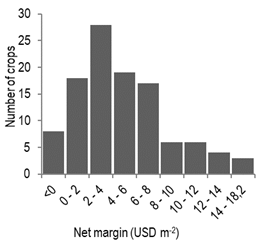Horticultural systems based on greenhouse tomato in south Uruguay
characterization and analysis of economic efficiencies
DOI:
https://doi.org/10.31285/AGRO.24.87Keywords:
farming systems, net margin, production cost, profitabilityAbstract
Sustainable development of food production requires more productive, profitable, and resource-efficient farming systems. Economic efficiency depends on commercial yield, but also on the efficient use of inputs, their price, and the sale price of products; it is also related to farming system characteristics. This study aimed to assess resource endowment and structural characteristics of greenhouse tomato farms and how they affect the economic efficiency of tomato crop, delving into the analysis of the main causes of its variability. This study included 23 representative farms in south Uruguay and 110 tomato crops (two to three per farm) during 2014/2015 and 2015/2016 seasons. We found high variability in commercial yields, product quality, sale prices according to harvest time, and production costs. This resulted in significant variability in net margins among crops, from negative values to a maximum of usd 16.2 m-2. Four groups were distinguished according to farm characteristics. Large-scale farms had higher economic efficiency in tomato crops, however, farm scale group was not among the main factors responsible for crop net margin variability. The main cause of net margin variability in 2014/2015 and 2015/2016 was gross income variability. Yield and sale price explained net margin differences for all gross income levels. However, the price was more relevant within the group with higher gross income and yield within the lower gross income group. Production costs were only ranked in the group of higher gross income.
Downloads

Published
How to Cite
Issue
Section
| Article metrics | |
|---|---|
| Abstract views | |
| Galley vies | |
| PDF Views | |
| HTML views | |
| Other views | |

















